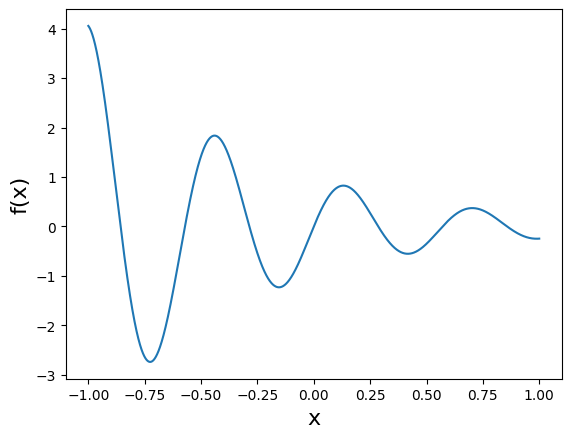Integrate a One-Dimensional Polynomial#
import numpy as np
import minterpy as mp
import matplotlib.pyplot as plt
import warnings
warnings.filterwarnings('ignore')
A definite integration operation may be carried for fully-specified Minterpy polynomials. This guide explains how to carry out a definite integration on a one-dimensional polynomial interpolant in different bases.
Motivating example#
Consider the following one-dimensional damped sine function:
An estimated value of this integral is \(0.0490183\).
Define the function in Python as follows:
def fun(xx):
return np.exp(-1.4 * xx) * np.sin(3.5 * np.pi * xx)
The plot of the function is shown in the figure below:
xx = np.linspace(-1, 1, 10000)
yy = fun(xx)
plt.plot(xx, yy)
plt.xlabel("x", fontsize=16)
plt.ylabel("f(x)", fontsize=16);

Polynomial interpolation#
In this guide, we are going to create a polynomial interpolant in Minterpy from scratch in four steps:
Define the multi-index set
Create the interpolation grid (of unisolvent nodes)
Evaluate the function on the grid
Create a polynomial interpolant in Lagrange basis
A polynomial interpolant of a given degree may be created using the Lagrange basis. First, create the multi-index set:
mi = mp.MultiIndexSet.from_degree(spatial_dimension=1, poly_degree=30, lp_degree=1.0)
We select a high enough polynomial degree to sufficiently interpolate the function. Then, create the interpolation grid given multi-index set:
grd = mp.Grid(multi_index=mi)
The grid contains unisolvent nodes on which the function should be evaluated as the coefficients of a polynomial in the Lagrange basis:
lag_coeffs = fun(grd.unisolvent_nodes)
Finally, a polynomial interpolant in Lagrange basis is created from the multi-index set and the set of coefficients:
lag_poly = mp.LagrangePolynomial(multi_index=mi, coeffs=lag_coeffs)
Note
In Minterpy, polynomials in the Lagrange basis cannot be directly evaluated. To evaluate an interpolating polynomial, the Newton basis is recommended.
Integration over the domain \([-1, 1]\)#
The method integrate_over() integrates the polynomial over the default domain of \([-1, 1]\):
int_value = lag_poly.integrate_over()
int_value
0.049018277818983005
Integration over specified bounds#
The bounds of the integration may be specified. For instance, to integrate the polynomial over \([-1, 0]\), provide the lower and upper bounds of the integration as follows:
lag_poly.integrate_over([-1, 0])
-0.04328650053261674
Similarly, to integrate the polynomial over \([0, 1]\):
lag_poly.integrate_over([0, 1])
0.09230477835159537
Integration in different bases#
The integration may also be carried out on the polynomial in different bases. The same method integrate_over() is used.
Below is the integration in the Newton basis:
nwt_poly = mp.LagrangeToNewton(lag_poly)()
nwt_poly.integrate_over()
0.0490182778189841
And in the canonical basis:
can_poly = mp.LagrangeToCanonical(lag_poly)()
can_poly.integrate_over()
0.049018433527192186
Warning
The integration of polynomials in the canonical basis having a high polynomial degree is not recommended as it may suffer from a severe instability.
